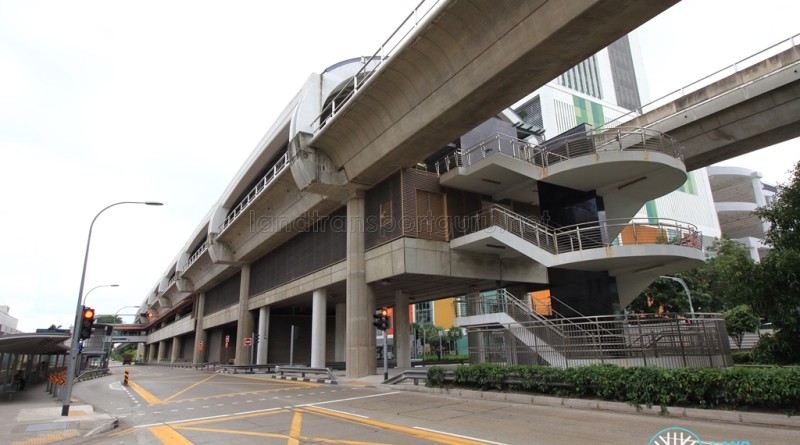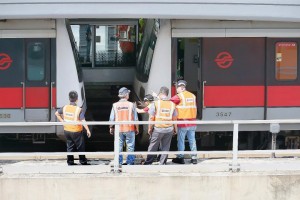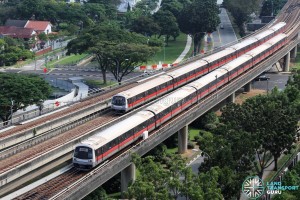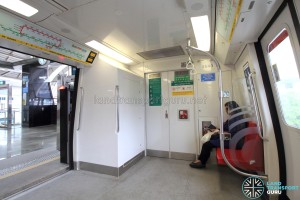| Joo Koon Train Collision |
|
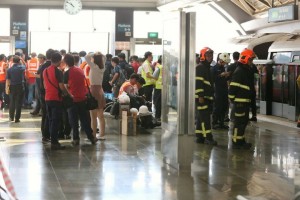 |
|
| Date / Time | 15 November 2017 |
| Location | Joo Koon MRT Station |
| Rail line | East West Line |
| Operator | SMRT Trains |
| Type of incident | Software failure in CBTC signalling system resulting in a collision between two trains |
| Cause | Software issues during switching of signalling systems resulting in inactivation of train protection |
| Train involved | 2x Kawasaki-Sifang C151A trains |
| Injuries | 38 (including 2 crew) |
The Joo Koon train collision occurred on 15 November 2017 when a moving train collided into the rear of a stationary train at the westbound platform of Joo Koon MRT Station along the East West Line (EWL), resulting in 36 injuries. Both trains involved were Kawasaki-Sifang C151A trains and were operating on the Communications-based train control (CBTC) signalling system, which was recently installed at the time of the incident.
The collision at Joo Koon was the second train collision in Singapore MRT’s history, after a 1993 accident at Clementi Station. The accident dealt a further blow on SMRT Corporation and the authorities in the wake of a tunnel flooding incident and multiple faults plaguing the reliability of the North South Line and East West Line.
Background
At the time of the incident, the Thales Seltrac Communications-based train control (CBTC) signalling system was gradually being introduced on the East West Line (EWL) to replace the legacy Westinghouse fixed-block signalling system, with the eventual goal of reducing intervals between trains across the entire line.
Both systems were in use on the same line at the time of the incident; however, the recently-opened Tuas West Extension was equipped only with the newer CBTC signalling system. As a result, trains travelling in both directions had to switch signalling systems at Pioneer. Between Tuas Link and Pioneer, trains were driven by the newer CBTC signalling, and between Pioneer and Pasir Ris, trains were driven by the older Westinghouse fixed-block signalling with the CBTC monitoring in ‘shadow mode’. All four models of rolling stock on the EWL, namely the Kawasaki Heavy Industries C151, Siemens C651, Kawasaki-Nippon Sharyo C751B and the Kawasaki-Sifang C151A, were equipped with both signalling systems.
Previous high-profile train disruptions which occurred during the testing of the CBTC signalling system on the North South Line (NSL) have also led to public grouses with the resignalling project. In return, the authorities urged for patience, with the promise of more reliable train services after the completion of rail renewal work.
Further reading:
How the incident unfolded:
The accident occurred at 8:20 am. Prior to social media postings by the public, SMRT had reported the incident as a “Train Fault”. Netizens took their experiences to social media, posting photos and their experience of the collision on Facebook. The Singapore Civil Defence Force (SCDF) later confirmed that there were injured passengers in a tweet at 10:45am.
At the onset of the incident, SMRT announced a 20-minute delay as bi-directional train services were routed through the unaffected eastbound platform at Joo Koon. Later in the day, train services were suspended between Joo Koon and Tuas Link to facilitate the recovery of the trains. A full timeline is attached at the bottom of this article.
A strong initial suspect in this rail collision incident was the operability of the signalling system during the incident. Trains operate on the new Communications-based train control (CBTC) signalling system from Pioneer to Tuas Link. Implemented earlier last year, faults with the new signalling system have plagued both the North South Line (NSL) and Tuas West Extension (EWL) with a history of regular signalling faults, although most issues have been ironed out prior to the incident.
Trains switch from the old Westinghouse fixed-block system to the Thales CBTC system at Pioneer Station in both directions of the EWL. As Joo Koon is firmly within CBTC operating zones, emergency brakes should have activated on the moving train when it violated its limit of movement authority.
At 11:18am, SMRT released its first official statement via its Facebook page:
This incident was the second collision incident to affect the Singapore MRT network. The first MRT collision occurred during the morning peak hours of 5 August 1993 at Clementi station towards Jurong, resulting in 156 injured passengers. It was caused by a 50-litre oil spill from a maintenance locomotive.
Preliminary Sequence of Events
In a press conference on the night of 15 November 2017, LTA, SMRT Trains & Thales elaborated on their preliminary reconstruction of events. Details of the incident were extracted from the press conference, including the LTA-SMRT joint statement as well as the Question & Answer segment of the press conference.
Another press conference was held on Tuesday, 21 November 2017 with more details regarding the incident.
Two days before the incident, Thales connected the passive CBTC system with the active CBTC system. Prior to this, both passive and active CBTC systems on the East West Line were isolated.
On the morning of 15 November 2017, at 5:38am, trainset 535/536 (a Kawasaki-Sifang C151A train) departed Ulu Pandan Depot in the eastbound direction and began revenue service on the East West Line, turning around at Pasir Ris. At the reception track of Ulu Pandan Depot, before joining the eastbound mainline, the train encountered “an abnormal condition within the CBTC train borne signalling equipment”. This condition is likely to be the interrupted connection between the 2 Vehicle On-Board Controllers (VOBC) located at both ends of the train, resulting in the train to be reflected as a “3-car configuration” on the new (Thales SelTrac CBTC) signalling system instead of the actual 6-car operation configuration of NSL and EWL Trains. This is referred to as the first CBTC protective bubble.
As a protection layer against faults like the above-mentioned, Thales has developed and implemented the Non-Communicating Obstruction (NCO) “software protection module”. When the NCO is activated, trains are only able to move in Restricted Manual (RM) mode, at a maximum speed of 18 km/h. This is referred to as the second CBTC protective bubble.
The NCO was disabled when the train passed by Point W210B near Clementi MRT Station whose circuit was yet to be modified for the new CBTC signalling system. By design, the train should only able to operate in RM at 18km/h under the CBTC system. However, as the CBTC signalling system is only operated under a shadow mode between Pioneer and Pasir Ris, the train continued to operate normally under the Legacy signalling system.
Train Captains are only required to monitor instruments related to the Legacy signalling system between Pioneer and Pasir Ris as it is the signalling system used by trains for that stretch. The CBTC signalling instruments are not visible to Train Captains along that stretch.
While transiting between the old (Legacy Westinghouse fixed block system) and new signalling system at Pioneer MRT Station towards Tuas Link, the train can only travel, by design, only at 18km/h in RM due to the earlier signalling abnormality which is only visible to the Train Captain from Pioneer to Tuas Link. The Train Captain reported the abnormally to the Operations Control Centre (OCC) immediately at Pioneer. By procedure, the train was planned to return to Ulu Pandan Depot after de-training passengers at Joo Koon.
The Train Captains and Train Controllers were taught that there would always be at least a protective bubble under the active CBTC system.
At 0818hrs, this faulty train pulled into Joo Koon MRT Station (Platform B) to detrain passengers due to “an anomaly in the train signalling system”. The station’s Half-Height Platform Screen Doors had to be manually operated via a switch located at the HeadWall of the Platform (front end of the platform). Once the platform screen doors were opened, Track Circuit Protection (TCP) was applied, which indicates to the new signalling system that the entire Platform B of Joo Koon MRT Station was occupied.
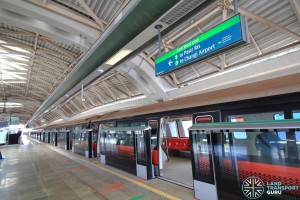
At 0819hrs, the rear train, another C151A Train (trainset 547/548), stopped 36m away from the rear of the faulty front train which was at Joo Koon MRT Station Platform B. This was due to the TCP that was in place for the faulty train at the platform. (Log findings indicated 36m instead as revealed during the second press conference instead of 10.6m estimation from video footage during the first conference)
At 0820hrs, after the detrainment of the faulty train at Joo Koon Platform B, the Train Captain closed the Platform Screen Doors, which resulted in the TCP being lifted to allow the faulty train to move off. As the faulty train was only reflected as a 3-car configuration in the signalling system, the rear train (547/548) started to move forward automatically under the control of the new signalling system which wrongly assumed that it was clear to proceed. It collided with the stationary train at about 16 km/h, pushing it forward by the length of roughly two doors.
At least 36 people on the rear train (trainset 547/548) were injured, including the Train Captain, an Assistant Station Manager and 6 Malaysian commuters. There were a total of 517 passengers onboard the rear train at the time of the incident, while the front train had no passengers onboard. The 36 injured people also included commuters who independently sought medical attention at hospitals after the incident.
The Train Captain of Trainset 547/548 had 1.5 years of driving experience on the North South and East West Lines at the time of the incident.
Aftermath
Immediate aftermath
East West Line Delay & Suspension
As a result of the train collision at 0820hrs, SMRT advised commuters via various channels such as in-train/in-station announcements as well as on Social Media.
- 0825hrs: To add 20 minutes additional train travel time from Jurong East to Joo Koon due to “a train fault at Joo Koon”
- 0835hrs: Free regular bus services between Jurong East and Tuas Link stations activated
- 0837hrs: To add 30 minutes additional train travel time from Jurong East to Tuas Link due to “a train fault at Joo Koon”, and that train service is still available
- 0926hrs: To add 30 minutes additional train travel time from Queenstown to Tuas Link due to “a train fault at Joo Koon”
- 0958hrs: To add 15 minutes additional train travel time from Jurong East to Tuas Link
- 1031hrs: To add 10 minutes additional train travel time from Boon Lay to Tuas Link
- 1358hrs: No Train Service between Boon Lay and Tuas Link. Free bridging bus services and free regular bus services available between Boon Lay and Tuas Link
- 1715hrs: Train Service between Boon Lay and Tuas Link resumed, with an additional 10 minutes travelling time from Boon Lay to Tuas Link
- 1734hrs: Free bridging bus services and free regular bus services between Boon Lay and Tuas Link ended
Reduced North South Line Trains
As a precaution to prevent a similar incident on the North South Line, as it is operated using the new CBTC signalling system, the number of trains deployed during the evening peak hours on 15 November 2017 were reduced to allow for a larger gap between trains.
SMRT advised commuters via various channels such as in-train/in-station announcements as well as on Social Media regarding this as well.
- 1705hrs: Additional 15 minutes train travel time on the entire North South Line due to fewer trains serving. Free one-way bus bridging service from Bishan to Yishun were available, as well as two-way free regular bus boarding at Bishan, Ang Mo Kio, Yio Chu Kang, Khatib & Yishun.
- 1745hrs: Additional 25 minutes train travel time on the entire North South Line
- 1829hrs: Additional 40 minutes train travel time on the entire North South Line
- 2019hrs: The free one-way bus bridging service from Bishan to Yishun as well as the two-way free regular bus boarding at Bishan, Ang Mo Kio, Yio Chu Kang, Khatib & Yishun has ceased
- 2218hrs: Normal train service on the North South Line
The Days Ahead
Short-term suspension of Joo Koon—Tuas Link
Following the incident on 15 November 2017, arrangements were made by LTA, SMRT and Thales to facilitate the investigation to the incident. From 16 to 19 November 2017, train services from Joo Koon—Tuas Link were suspended, and free bridging bus services were provided between Joo Koon—Tuas Link. Changes to train services are detailed at Suspension & Changes to Train Service on Tuas West Extension.
Long-term closure of Joo Koon—Gul Circle
From 20 November 2017, train services resumed between Gul Circle—Tuas Link, but services between Joo Koon—Gul Circle remain suspended. The decision was made to isolate the two different signalling systems ‘for about a month’ until a solution to the switching of signalling systems was found. This arrangement was done to separate the old signalling system-equipped section between Pasir Ris and Joo Koon from the new signalling system-equipped section between Joo Koon and Tuas Link, hence no longer requiring trains to switch signalling systems at Pioneer (Tracks between Pioneer and Joo Koon can be operated on either the old or new signalling system).
However, on 21 November 2017, an announcement was made to extend the closure until mid-2018 when resignalling works on the EWL were projected to be complete, so as to fully prevent a similar incident from occurring again. In the meantime, a Free Bridging Bus service was offered for commuters between Gul Circle—Tuas Link during rail operating hours.
Changes to train services are detailed at Suspension & Changes to Train Service on Tuas West Extension, and shuttle bus arrangements are detailed at Joo Koon—Gul Circle Free Shuttle Bus Service.
Shortened operating hours for accelerated maintenance
To accelerate the CBTC resignalling project on the EWL as well as additional engineering works, the operating hours will be shortened for sections of the EWL and NSL. This would comprise early closures, late openings and full day closures, with Bridging Bus Services offered to commuters during periods of closure.
Works started in December 2017 with shortened operating hours implemented along Tuas Link—Outram Park (EWL), and Jurong East—Choa Chu Kang (NSL) on various Fridays, Saturdays and Sundays. Detailed arrangements are outlined in Shortened Operating Hours on East West & North South Lines (Dec 2017).
Resumption of Train Service
Train service between Joo Koon and Gul Circle resumed during the Sunday full day East West Line new signalling system trials in April & May 2018, and subsequently fully restored from 27 May 2018, as weekday trials of the new signalling system began on the East West Line.
External Links & References:
- MRT train collides with stationary train at Joo Koon station; 29 people hurt – Channel NewsAsia [Accessed 15/11/2017]
- Joo Koon train collision: 28 hurt after stalled train is hit by another one – Straits Times [Accessed 15/11/2017]
- 6 Malaysians among 29 hurt in Wednesday’s train collision at Joo Koon MRT station – Straits Times [Accessed 16/11/2017]
- LTA-SMRT-Thales Press Conference (Full) – Channel 8 News (Facebook) [Accessed 15/11/2017]
- 2nd LTA-SMRT-Thales Press Conference (Full) – Channel 8 News (Facebook) [Accessed 21/11/2017]
